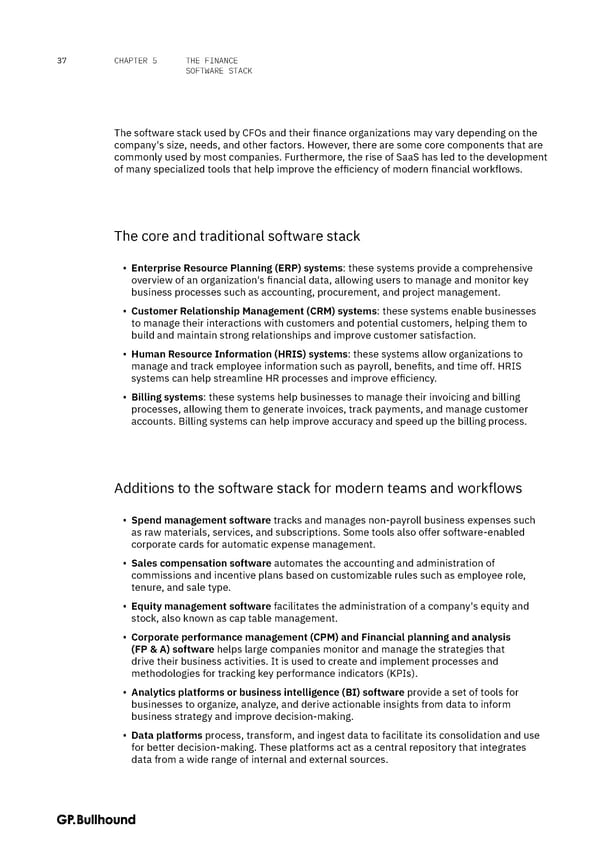37 CHAPTER 5 THE FINANCE SOFTWARE STACK The software stack used by CFOs and their finance organizations may vary depending on the company's size, needs, and other factors. However, there are some core components that are commonly used by most companies. Furthermore, the rise of SaaS has led to the development of many specialized tools that help improve the efficiency of modern financial workflows. The core and traditional software stack ▪ Enterprise Resource Planning (ERP) systems: these systems provide a comprehensive overview of an organization's financial data, allowing users to manage and monitor key business processes such as accounting, procurement, and project management. ▪ Customer Relationship Management (CRM) systems: these systems enable businesses to manage their interactions with customers and potential customers, helping them to build and maintain strong relationships and improve customer satisfaction. ▪ Human Resource Information (HRIS) systems: these systems allow organizations to manage and track employee information such as payroll, benefits, and time off. HRIS systems can help streamline HR processes and improve efficiency. ▪ Billing systems: these systems help businesses to manage their invoicing and billing processes, allowing them to generate invoices, track payments, and manage customer accounts. Billing systems can help improve accuracy and speed up the billing process. Additions to the software stack for modern teams and workflows ▪ Spend management software tracks and manages non-payroll business expenses such as raw materials, services, and subscriptions. Some tools also offer software-enabled corporate cards for automatic expense management. ▪ Sales compensation software automates the accounting and administration of commissions and incentive plans based on customizable rules such as employee role, tenure, and sale type. ▪ Equity management software facilitates the administration of a company's equity and stock, also known as cap table management. ▪ Corporate performance management (CPM) and Financial planning and analysis (FP & A) software helps large companies monitor and manage the strategies that drive their business activities. It is used to create and implement processes and methodologies for tracking key performance indicators (KPIs). ▪ Analytics platforms or business intelligence (BI) software provide a set of tools for businesses to organize, analyze, and derive actionable insights from data to inform business strategy and improve decision-making. ▪ Data platforms process, transform, and ingest data to facilitate its consolidation and use for better decision-making. These platforms act as a central repository that integrates data from a wide range of internal and external sources.
 The CFO Handbook | GP Bullhound Page 36 Page 38
The CFO Handbook | GP Bullhound Page 36 Page 38